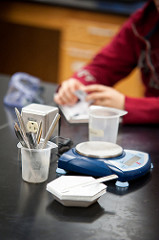How many "labs?"
By Mary Bigelow
Posted on 2016-11-16
 I’m a first-year biology teacher. How do I decide how many labs I could or should do each week. My colleagues have different ideas about this. —L., South Carolina
I’m a first-year biology teacher. How do I decide how many labs I could or should do each week. My colleagues have different ideas about this. —L., South Carolina
Sometimes the word lab is used to describe any activities students do in groups in science class including investigations, experiments, projects, teacher demonstrations, laptop or tablet activities, simulations, games, small-group discussions, and group writing assignments.
While these activities can be useful learning strategies, let’s assume you are referring to studying a phenomenon or answering a question through investigations, experiments, projects, or constructing and using models.
Some of these studies may take less than a class period, while other investigations may require more time or even a long-term commitment spanning several days, weeks, or months. Many teachers often start with an activity prior to presenting content to provide students with a context.
In terms of learning science, the quality of the activities is more important than the quantity. The type and number of activities depend on the learning goals, student interests, and whether an activity can be done safely in your classroom with the materials and time you have.
Doing an activity for its own sake without a meaningful context or without student input, follow-up, or reflection leads to questions about what students are learning and whether they truly understand the relationships and connections among concepts, practices, and content. (I once overheard a teacher saying “I keep my students so busy they don’t have time to think.”)
So…I don’t have a definitive answer to your question. But I would advise against using “labs” as an incentive for good behavior or take them away as a consequence for unrelated behavior. Of course, if students are engaging in unsafe or dangerous behavior during the activity, you will have to deal with that situation immediately.
Disclaimer: The views expressed in this blog post are those of the author(s) and do not necessarily reflect the official position of the National Science Teaching Association (NSTA).


